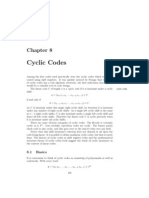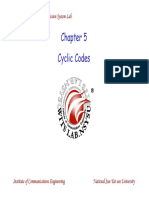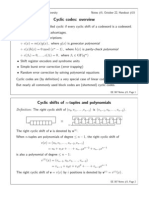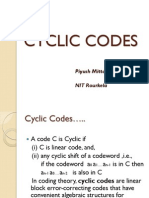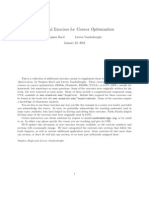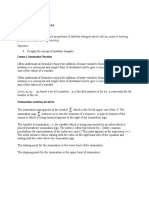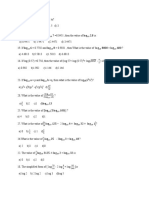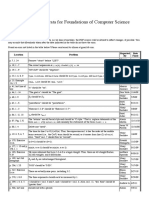ECE 7670 Lecture 5 - Cyclic Codes
ECE 7670 Lecture 5 - Cyclic Codes
Uploaded by
Akira KurodaCopyright:
Available Formats
ECE 7670 Lecture 5 - Cyclic Codes
ECE 7670 Lecture 5 - Cyclic Codes
Uploaded by
Akira KurodaOriginal Description:
Original Title
Copyright
Available Formats
Share this document
Did you find this document useful?
Is this content inappropriate?
Copyright:
Available Formats
ECE 7670 Lecture 5 - Cyclic Codes
ECE 7670 Lecture 5 - Cyclic Codes
Uploaded by
Akira KurodaCopyright:
Available Formats
ECE 7670
Lecture 5 Cyclic codes
Objective: To become acquainted with the basic concepts of cyclic codes and
some aspects of encoder implementations for them.
Reading:
Chapter 5.
1 Cyclic codes
Denition 1 An (n, k) linear block code C is said to be cyclic if for every code
word c = (c
0
, c
1
, . . . , c
n1
) in C, there is also a code word c
= (c
n1
, c
0
, . . . , c
n2
)
that is also in C. (c
is a cyclic shift of c.) 2
It will be convenient to represent our codewords as polynomials. The codeword
c = (c
0
, c
1
, . . . , c
n1
)
is represented by the polynomial
c(x) = c
0
+c
1
x + +c
n1
x
n1
using the obvious one-to-one correspondence. A cyclic shift can therefore be repre-
sented as follows. Observe that
xc(x) = c
0
x +c
1
x + +c
n1
x
n
.
If we not take this product modulo x
n
1 we get
xc(x) (mod x
n
1) = c
n1
+c
0
x + +x
n2
x
n1
.
So multiplication by x in the ring GF(q)[x]/(x
n
1) corresponds to a cyclic shift.
Furthermore, any power of x times a codeword yields a codeword (apply the de-
nition recursively), so that, for example,
(c
n1
, c
0
, c
1
, . . . , c
n2
) xc(x)
(c
n2
, c
n1
, c
0
, . . . , c
n3
) x
2
c(x)
.
.
.
(c
1
, c
2
, . . . , c
n1
, c
0
) x
n1
c(x)
where the arithmetic is done in the ring GF(q)[x]/(x
n
1). Now observe that if we
take an polynomial a(x) GF(q)[x] of the form
a(x) = a
0
+a
1
x + +a
n1
x
n1
then
c(x)a(a)
is simply a linear combination of cyclic shifts of c(x) and hence, must also be a
codeword. Hence: a cyclic code is an ideal in GF(q)[x]/(x
n
1). Because of
what we know about ideals in GF(q)[x]/(x
n
1) we can immediately make some
observations about cyclic codes:
A cyclic code has a generator polynomial g(x), which is the generator of the
ideal. Let the degree of g be r, where r < n.
ECE 7670: Lecture 5 Cyclic codes 2
Every code polynomial in the code can be expressed as a multiple of the
generator.
c(x) = m(x)g(x),
where m(x) is the message polynomial. The degree of m is less than n r.
The generator is a factor of x
n
1 in GF(q)[x].
Example 1 We will consider cyclic codes of length 15 with binary coecients. We
need to nd the factors of x
n
1 in some eld. Observe that
15|2
4
1,
so we are dealing in the eld GF(16). The conjugacy classes in GF(16) are
{1} x + 1
{,
2
,
4
,
8
} 1 +x +x
4
{
3
,
6
,
9
,
12
} 1 +x +x
2
+x
3
+x
4
{
5
,
10
} 1 +x +x
2
{
7
,
14
,
13
,
11
} 1 +x
3
+x
4
Thus
x
15
1 = (x + 1)(1 +x +x
4
)(1 +x +x
2
+x
3
+x
4
)(1 +x +x
2
)(1 +x
3
+x
4
)
So: degrees 1,2,4,4,4. If we want a generator of, say, degree 9, we could take
g(x) = (x + 1)(1 +x +x
4
)(1 +x +x
2
+x
3
+x
4
)
If we want a generator of degree 5 we could take
g(x) = (x + 1)(1 +x +x
4
)
or
g(x) = (x + 1)(1 +x +x
2
+x
3
+x
4
)
In fact, in this case, we can get generator polynomials of any degree from 1 to 15.
So we have codes
(15, 0)(15, 1), . . . , (15, 15)
2
A message sequence (m
0
, m
1
, . . . , m
k1
) (where k = n r) corresponds to a
message polynomial
m(x) = m
0
+ +m
k1
x
k1
.
Then the message polynomial corresponding to m is
c
m
(x) = m(x)g(x).
We can write this as
c
m
(x) = [m
0
, m
1
, . . . , m
k1
]
g(x)
xg(x)
.
.
.
x
k1
g(x)
ECE 7670: Lecture 5 Cyclic codes 3
Taking the next step, we can go back to a matrix representation,
c
m
=
m
0
, m
1
, . . . , m
k1
g
0
g
1
g
r
g
0
g
1
g
r
g
0
g
1
g
r
.
.
.
.
.
.
.
.
.
g
0
g
1
g
r
g
0
g
1
g
r
= mG
So we have a linear code, and can write the generator matrix corresponding to it.
Note: G is k n.
Let h(x) be parity check polynomial, that is a polynomial such that
x
n
1 = g(x)h(x).
Since codewords are multiples of g(x), then for a codeword,
c(x)h(x) = m(x)g(x)h(x) = m(x)(x
n
1) 0 (mod x
n
1).
We let
s(x) = c(x)h(x) (mod x
n
1).
be the syndrome polynomial. If s(x) is identically zero, then c(x) is a codeword.
Now lets put this in matrix form.
s(x) = c(x)h(x) =
n1
i=0
c
i
x
i
n1
j=0
h
j
x
j
(mod x
n
1).
Performing the multiplication,
s
k
=
n1
i=0
c
i
h
((ki))n
k = 0, 1, . . . , n 1.
Writing the last n k of these out, we have
[s
k
, s
k+1
, . . . , s
n1
] = [c
0
, c
1
, . . . , c
n1
]
h
k
h
k1
h
1
h
0
h
k
h
k1
h
1
h
0
.
.
.
.
.
.
h
k
h
k1
h
1
h
0
h
k
h
k1
h
1
h
0
T
= cH
T
.
Note: H is n k n
Example 2 Some cyclic codes of length 7. In GF(8) we have elements of order 7.
The minimal polynomials are
x + 1 x
3
+x + 1 x
3
+x
2
+ 1
We can choose any combination of these factors as factors of g(x). Let us take
g(x) = (x
3
+x + 1)(x + 1) = x
4
+x
3
+x
2
+ 1
Then h(x) = x
3
+x
2
+ 1. Here is the list of codewords
m(x)g(x) code polynomial code word
0g(x) 0 0000000
1g(x) 1 +x
2
+x
3
+x
4
1011100
xg(x) x +x
3
+x
4
+x
5
0101110
x
2
g(x) x
2
+x
4
+x
5
+x
6
0010111
(x
2
+ 1)g(x) 1 +x
3
+x
5
+x
6
1001011
(x
2
+x + 1)g(x) 1 +x +x
4
+x
6
1100101
(x + 1)g(x) 1 +x +x
2
+x
5
1110010
(x
2
+x)g(x) x +x
2
+x
3
+x
6
0111001
ECE 7670: Lecture 5 Cyclic codes 4
The corresponding generator and parity check matrix are
G =
1 0 1 1 1 0 0
0 1 0 1 1 1 0
0 0 1 0 1 1 1
H =
1 1 0 1 0 0 0
0 1 1 0 1 0 0
0 0 1 1 0 1 0
0 0 0 1 1 0 1
2
The codes to this point have not been systematic, but are easy to produce. We
will now do some tricks to make the code be systematic. We take the message block
m = (m
0
, m
1
, . . . , m
k1
) m(x) = m
0
+m
1
x + +m
k1
x
k1
.
Now take the code polynomial and shift it:
x
nk
m(x) = m
0
x
nk
+m
1
x
nk+1
+ +m
k1
x
n1
.
Observe that the code sequence corresponding to this is
(0, 0, . . . , 0, m
0
, m
1
, . . . , m
k1
)
Now we employ the division algorithm (this is the trick) to write
x
nk
m(x) = q(x)g(x) +d(x),
where d(x) has degree less than n k. That is, d(x) has the code sequence
(d
0
, d
1
, . . . , d
nk1
, 0, 0, . . . , 0)
Now form
x
nk
(x) d(x) = q(x)g(x).
Since the LHS is a multiple of g(x), it is a codeword. It has the form
(d
0
, d
1
, . . . , d
nk1
, m
0
, m
1
, . . . , m
k1
)
We have thus obtained a codeword in which the message data appears explicitly.
We have obtained by this trick a systematic code.
Example 3 We will demonstrate systematic coding in the (7, 3) code from before.
Let m(x) = 1 +x
2
from (1,0,1).
1. Compute x
nk
m(x) = x
4
m(x) = x
6
+x
4
.
2. Employ the division algorithm:
x
6
+x
4
= (x
2
+x + 1)(x
4
+x
3
+x
2
+ 1) + (x + 1).
3. Then our code polynomial is
c(x) = x
nk
m(x) d(x) = (1 +x) + (x
6
+x
4
) (1, 1, 0, 0, 1, 0, 1).
We can still explicitly see the message part. 2
2 Some hardware considerations
One of the justications for using cyclic codes, and using the polynomial repre-
sentation in general, is that there are some interesting and ecient hardware con-
gurations for performing the encoding operation. This has been of particularly
historical importance.
ECE 7670: Lecture 5 Cyclic codes 5
2.0.1 Galois eld operations
If we represent elements in a Galois eld using the m-tuple representation, addition
is easy, element-by element, using exclusive-or gates to perform the addition.
Multiplication by a xed Galois eld element is also fairly straightforward. Let
us take, as an example, multiplication in GF(2
4
). Let be in GF(2
4
), and represent
it as
= b
0
+b
1
+b
2
2
+b
3
3
.
That is, has the m-tuple representation (b
0
, b
1
, b
2
, b
3
). Let g be a xed element in
GF(2
4
), and suppose for this example, that g = 1 +. Let = g. Then
= c
0
+c
1
+c
2
2
+c
3
3
= (b
0
+b
1
+b
2
2
+b
3
3
)(1 +)
= b
0
+ (b
0
+b
1
) + (b
1
+b
2
)
2
+ (b
2
+b
3
)
3
+b
3
4
= (b
0
+b
3
) + (b
0
+b
1
+b
3
) + (b
1
+b
2
)
2
+ (b
2
+b
3
)
3
.
A hardware implementation is straightforward. (Draw a diagram.)
2.0.2 Polynomial multiplication
Now to compute m(x)g(x). This is simply a feed-forward (FIR) lter. The message
bits are fed in in descending order: m
k1
, m
k2
, . . . , m
0
:
As a specic example, we have, for g(x) = 1 +x
2
+x
3
+x
4
the following
Consider a specic example: m(x) = m
0
+m
1
x+m
2
x
2
and g(x) = g
0
+g
1
x+g
2
x
2
.
What about further shifts?
For the systematic encoding, we have three steps:
ECE 7670: Lecture 5 Cyclic codes 6
1. Multiply by x
nk
. This is accomplished by feeding into the middle of the shift
register:
2. Divide by g(x). Polynomial division is obtained using LFSR. To forma(x)/g(x),
we recognize (from signal processing experience) that division is accomplished
using a feedback connection.
The inputs are fed in in decreasing index order: a
n1
, a
n2
, . . . , a
0
. After the
last symbol has been fed in, the LFSR contains the remainder of a(x)/g(x).
ECE 7670: Lecture 5 Cyclic codes 7
3. Set c(x) = x
nk
m(x)d(x). Here we simply employ some switching circuitry:
Start in X: pass in message, which appears at output and goes into divider.
Then switch to Y and read out the parity bits.
3 Syndrome decoding
We now examine the question of decoding cyclic codes. Recall that for any linear
code, we can form a standard array; or we can use the reduced standard array using
syndromes. We will be able to exploit the cyclic structure of the codes to decrease
the memory requirements.
Consider the systematically-encoded codeword
c = (d
0
, d
1
, . . . , d
nk1
, m
0
, m
1
, . . . , m
k1
) = (d, m)
We can perform error detection as follows:
1. Estimate a message based on the systematic message part. Call this m
.
2. We then encode m
. Compute the parity bits from this to the received parity
bits. If they dont match, then an error is detected.
We can also use shift-register techniques. Recall that if we take r(x)h(x) modulo
x
n
1, we get a syndrome polynomial. But since
g(x)h(x) = x
n
1
we can use the division algorithm, dividing by g(x)
r(x) = a(x)g(x) +s(x).
But the division we can compute as we saw before.
We have the following useful result about cyclic codes and syndromes.
ECE 7670: Lecture 5 Cyclic codes 8
theorem 1 Let s(x) be the syndrome corresponding to r(x). Let r
(1)
(x) be the
polynomial obtained by cyclicly right-shifting r(x). Then the remainder obtained
when dividing xs(x) by g(x) is the syndrome denoted s
(1)
corresponding to r
(1)
(x).
In other words, shifts of r (mod x
n
1) correspond to shifts of s (modulo g).
Proof Write
r
(1)
(x) = xr(x) r
n1
(x
n
1).
(Show how this works.) Let us write
r(x) = a(x)g(x) +s(x).
Then
r
(1)
(x) = x[a(x)g(x) +sb(x)] r
n1
[g(x)h(x)].
Let us write this as
r
(1)
(x) = b(x)g(x) +d(x).
We note that d(x) must be the syndrome of r
(1)
(x). We also note from the previous
result, solving for xs(x),
xs(x) = [b(x)g(x)+d(x)]xa(x)g(x)+r
n1
g(x)h(x) = (b(x)xa(x)+r
n1
h(x))g(x)+d(x).
Thus d(x) is the remainder of xs(s) divided by g(x), establishing the theorem. 2
We conclude we can reduce the size of the syndrome lookup table. We need to only
store one syndrome s for an error e and all cyclic shifts of e. And we can compute
the shifts necessary using the same circuit that computes the syndrome in the rst
place.
Example 4
error syndrome syndrome poly
0000000 000 0
1000000 100 1
0100000 010 x
0010000 001 x
2
0001000 110 1 +x
0000100 011 x +x
2
0000010 111 1 +x +x
2
0000001 101 1 +x
2
Comment on the pattern. So all we have to do in this case is look for is any one
of the syndrome patterns (instead of many of them). We choose to look for 101,
ECE 7670: Lecture 5 Cyclic codes 9
since if we nd the error in that location, we can shift correct it on the end.
2
4 CRC codes
CRC codes are very commonly used for ARQ (automatic repeat request). Every
modem and network protocol uses ARQ, reverse error correction, even where for-
ward error correction may not be. They provide powerful error detection capability,
and are easily implemented. They are appropriate to talk about here, because they
are basically cyclic codes, with syndrome computation computed using LFSR.
CRC codes are simply binary cyclic codes with particular polynomials, chosen
to obtain good error detection capability.
We will explain the idea using notation from Data and Computer Communica-
tions by W. Stallings (5th Ed., Prentice-Hall). Let M(x) be a message polynomial
of degree k 1, and let R(X) be a parity check polynomial of degree n 1. Then
form
T(x) = x
n
M(x) +R(x).
Then we have a systematic representation of M(x) in T. This is the encoding
operation. The decoder takes the received signal and divides by some polynomial
P(x). We want to choose R(x) so that the remainder when T(x) is divided by P(x)
ECE 7670: Lecture 5 Cyclic codes 10
is exactly zero. We obtain R(x) as follows: Observe that we can write
x
n
M(x)
P(x)
= Q(x) +
r(x)
P(x)
Then if we set R(x) = r(x) (the remainder) we get the zero remainder that we
want. That is, we encode by forming
T(x) = x
n
M(x) +R(x).
Then we decode by dividing:
T(x)
P(x)
=
x
n
M(x) +R(x)
P(x)
= Q(x) +
R(x)
P(x)
+
R(x)
P(x)
= Q(x).
(all operations in GF(2)).
Example 5 Let M = 1010001101 M(x) = x
9
+ x
7
+ x
3
+ x
2
+ 1 and P =
110101 P(x) = x
5
+x
4
+x
2
+ 1.
1. Message is shifted by 2
5
, yielding 10100011010000.
2. Product is divided by P:
3. The remainder R = 01110 is added to give T = 101000110101110.
ECE 7670: Lecture 5 Cyclic codes 11
4. At the receiver, divide again by P:
If there is no remainder, it is assumed that there have been no errors.
2
A couple of common polynomials:
CRC-16x
16
+x
14
+x
2
+ 1
CRC-CCITTx
16
+x
12
+x
5
+ 1
How well do they work? We rst observe that an error is undetectable only if it
is divisible by P(x). A summary of some performance results follows for detectable
errors.
All single-bit errors.
All double-bit errors if weight(P(x)) 3.
Any odd number of errors if x + 1|P(x).
Any burst error for which the length of the burst is less than the length of
P(x).
Most larger burst errors.
The book provides some specics: CRC-16 or CRC-CCITT detects the following:
1. All single bursts of length 16 or less.
2. 99.997% of all error bursts of length 17.
3. 99.9985% of all error bursts of length > 17.
You might also like
- 5CS3-01: Information Theory & Coding: Unit-4 Cyclic CodeDocument67 pages5CS3-01: Information Theory & Coding: Unit-4 Cyclic CodePratapNo ratings yet
- H2 Mathematics Cheat Sheet by Sean LimDocument27 pagesH2 Mathematics Cheat Sheet by Sean LimGale HawthorneNo ratings yet
- EXIM LdapDocument65 pagesEXIM LdapKampechano100% (1)
- Cyclic Codes: 8.1 BasicsDocument23 pagesCyclic Codes: 8.1 BasicsAnju SavithriNo ratings yet
- Cyclic Code FileDocument24 pagesCyclic Code FileShivend_Shiv_6977No ratings yet
- Cyclic CodesDocument24 pagesCyclic CodesFilston RukerandangaNo ratings yet
- CHAPTER 3: Cyclic and Convolution CodesDocument30 pagesCHAPTER 3: Cyclic and Convolution CodesHamzah NaserNo ratings yet
- Coding Theory Linear Cyclic Codes: 0 1 N 1 N 1 N NDocument19 pagesCoding Theory Linear Cyclic Codes: 0 1 N 1 N 1 N NvijaykannamallaNo ratings yet
- Cyclic Codes: Wireless Information Transmission System LabDocument119 pagesCyclic Codes: Wireless Information Transmission System LabRisha Jain100% (1)
- CHAPTER 03 - Cyclic CodesDocument30 pagesCHAPTER 03 - Cyclic CodessuthasenthilNo ratings yet
- Cyclic Codes: Overview: EE 387, John Gill, Stanford University Notes #5, October 22, Handout #15Document24 pagesCyclic Codes: Overview: EE 387, John Gill, Stanford University Notes #5, October 22, Handout #15sandipgNo ratings yet
- Cyclic CodesDocument42 pagesCyclic CodesAnuNo ratings yet
- Cyclic and BCH CodesDocument47 pagesCyclic and BCH Codesgauarv vermaNo ratings yet
- Unit 5 - 2 Cyclic CodesDocument30 pagesUnit 5 - 2 Cyclic CodesManohar UdayagiriNo ratings yet
- Crypto 03Document65 pagesCrypto 03sunil8080No ratings yet
- ch5 20211021Document29 pagesch5 20211021陳瑞笙No ratings yet
- Improper Integral1Document25 pagesImproper Integral1Lev DunNo ratings yet
- Cyclic Code-LIMDocument20 pagesCyclic Code-LIMKURNIVAN NOER YUSVIANTONo ratings yet
- Chapter One Polynomials: 1-1 Introduction Definition 1.1: A Monomial in Variable X Is An Expression of The Form C XDocument28 pagesChapter One Polynomials: 1-1 Introduction Definition 1.1: A Monomial in Variable X Is An Expression of The Form C Xعبداللە عمر ابراهیمNo ratings yet
- I2IT Cyclic Block CodesDocument46 pagesI2IT Cyclic Block CodesAbhijit V ChitreNo ratings yet
- Lecture 1 U 2Document15 pagesLecture 1 U 2Noor AlshibaniNo ratings yet
- MRRW Bound and Isoperimetric Problems: 6.1 PreliminariesDocument8 pagesMRRW Bound and Isoperimetric Problems: 6.1 PreliminariesAshoka VanjareNo ratings yet
- Convex Analysis and Optimization Solution ManualDocument193 pagesConvex Analysis and Optimization Solution ManualReza Alizadeh100% (2)
- Problem Set 2 Solution Numerical MethodsDocument15 pagesProblem Set 2 Solution Numerical MethodsAriyan JahanyarNo ratings yet
- Cyclic Codes: Saravanan Vijayakumaran Sarva@ee - Iitb.ac - inDocument25 pagesCyclic Codes: Saravanan Vijayakumaran Sarva@ee - Iitb.ac - insharukhsshaikhNo ratings yet
- Cyclic Codes: EE 430 / Dr. MuqaibelDocument55 pagesCyclic Codes: EE 430 / Dr. MuqaibelSrinidhi UpadhyayaNo ratings yet
- Slides 08 6 4Document6 pagesSlides 08 6 4mohammed229No ratings yet
- Cyclic CodesDocument18 pagesCyclic CodesPiyush MittalNo ratings yet
- On the difference π (x) − li (x) : Christine LeeDocument41 pagesOn the difference π (x) − li (x) : Christine LeeKhokon GayenNo ratings yet
- Lecture 14: BCH Codes: CS681 Computational Number TheoryDocument5 pagesLecture 14: BCH Codes: CS681 Computational Number TheoryChinmayee PaiNo ratings yet
- Winsem2017-18 Cse4003 Eth Sjt502 Vl2017185003779 Reference Material II Ecc1-MadhuDocument100 pagesWinsem2017-18 Cse4003 Eth Sjt502 Vl2017185003779 Reference Material II Ecc1-MadhuMayank SharmaNo ratings yet
- Linear Block Codes: Cyclic Codes: R Q NK N R NDocument27 pagesLinear Block Codes: Cyclic Codes: R Q NK N R NDuongMinhSOnNo ratings yet
- BV Cvxbook Extra ExercisesDocument165 pagesBV Cvxbook Extra ExercisesscatterwalkerNo ratings yet
- BV Cvxbook Extra Exercises2Document175 pagesBV Cvxbook Extra Exercises2Morokot AngelaNo ratings yet
- Problem 11.1: (A) : F (Z) Z X (Z) F (Z) F Z + ZDocument9 pagesProblem 11.1: (A) : F (Z) Z X (Z) F (Z) F Z + Zde8737No ratings yet
- 2 Nonlinear Programming ModelsDocument27 pages2 Nonlinear Programming ModelsSumit SauravNo ratings yet
- Hw3sol PDFDocument8 pagesHw3sol PDFShy PeachDNo ratings yet
- Scilab 6Document9 pagesScilab 6souvik5000No ratings yet
- Extra Exercises PDFDocument232 pagesExtra Exercises PDFShy PeachDNo ratings yet
- Convex OptimizationDocument152 pagesConvex OptimizationnudalaNo ratings yet
- Num Chap 1Document38 pagesNum Chap 1Sharif M Mizanur RahmanNo ratings yet
- BV Cvxbook Extra ExercisesDocument187 pagesBV Cvxbook Extra ExercisesMorokot AngelaNo ratings yet
- Lagrange Multipliers Can Fail To Determine Extrema: AcknowledgmentDocument3 pagesLagrange Multipliers Can Fail To Determine Extrema: Acknowledgmentarvind lakshmi ranjan100% (2)
- Notes 3Document8 pagesNotes 3Sriram BalasubramanianNo ratings yet
- Yogesh Meena (BCA-M15 4th SEM) CONM CCEDocument10 pagesYogesh Meena (BCA-M15 4th SEM) CONM CCEYogesh MeenaNo ratings yet
- Weatherwax - Conte - Solution - Manual Capitulo 2 y 3Document59 pagesWeatherwax - Conte - Solution - Manual Capitulo 2 y 3Jorge EstebanNo ratings yet
- Chapter 1 IntroductionDocument25 pagesChapter 1 IntroductionotternamedsteveNo ratings yet
- IIT Block CodesDocument12 pagesIIT Block CodesHarshaNo ratings yet
- Integration 110304071651 Phpapp01Document19 pagesIntegration 110304071651 Phpapp01Maan UsmanNo ratings yet
- Nonlinear Analysis Forum 19, Pp. 247-251, 2014Document6 pagesNonlinear Analysis Forum 19, Pp. 247-251, 2014Maher Ali NawkhassNo ratings yet
- BV Cvxbook Extra ExercisesDocument139 pagesBV Cvxbook Extra ExercisesAkhil AmritaNo ratings yet
- Systematic Cyclic Code: CX X DX XDocument16 pagesSystematic Cyclic Code: CX X DX XAlex parkarNo ratings yet
- Additional Exercises For Convex Optimization: Stephen Boyd Lieven Vandenberghe March 30, 2012Document143 pagesAdditional Exercises For Convex Optimization: Stephen Boyd Lieven Vandenberghe March 30, 2012api-127299018No ratings yet
- The Definite Integral SummationDocument7 pagesThe Definite Integral Summationmandy lagguiNo ratings yet
- Calculus II MAT 146 Additional Methods of Integration: Sin Sinx Sin Sinx 1 Cos Sinx Sinx Cos Sinxdx Sinx CosDocument7 pagesCalculus II MAT 146 Additional Methods of Integration: Sin Sinx Sin Sinx 1 Cos Sinx Sinx Cos Sinxdx Sinx Cosmasyuki1979No ratings yet
- A-level Maths Revision: Cheeky Revision ShortcutsFrom EverandA-level Maths Revision: Cheeky Revision ShortcutsRating: 3.5 out of 5 stars3.5/5 (8)
- Trigonometric Ratios to Transformations (Trigonometry) Mathematics E-Book For Public ExamsFrom EverandTrigonometric Ratios to Transformations (Trigonometry) Mathematics E-Book For Public ExamsRating: 5 out of 5 stars5/5 (1)
- Student Solutions Manual to Accompany Economic Dynamics in Discrete Time, second editionFrom EverandStudent Solutions Manual to Accompany Economic Dynamics in Discrete Time, second editionRating: 4.5 out of 5 stars4.5/5 (2)
- How To Setup Round Robin in Darts For Windows: Edition: 1p2Document7 pagesHow To Setup Round Robin in Darts For Windows: Edition: 1p2chaqif08No ratings yet
- Introduction To Actel FPGA Architecture PDFDocument8 pagesIntroduction To Actel FPGA Architecture PDFsaipranathi50% (2)
- Log FileDocument24 pagesLog FileTanya JainNo ratings yet
- Key Performance Indicators (Kpis) : Electronic Government Directorate (Strategic Planning & Architecture)Document6 pagesKey Performance Indicators (Kpis) : Electronic Government Directorate (Strategic Planning & Architecture)trueradNo ratings yet
- Tecnicas de Extricacion Vehicular Por Holmatro: AdvertisementDocument3 pagesTecnicas de Extricacion Vehicular Por Holmatro: AdvertisementJoel DominiciNo ratings yet
- CS 251 1099 Midterm ExamDocument9 pagesCS 251 1099 Midterm ExamSheethala SwaminathanNo ratings yet
- Office 2013 PRO PLUS Offline Activation Chei RETAILDocument5 pagesOffice 2013 PRO PLUS Offline Activation Chei RETAILPompei MititeanNo ratings yet
- 01-Fundamentals Configuration Guide-Book PDFDocument166 pages01-Fundamentals Configuration Guide-Book PDFEdson PintoNo ratings yet
- Problem Set 12Document3 pagesProblem Set 12ke QinNo ratings yet
- J ConsoleDocument24 pagesJ ConsolecidBookBeeNo ratings yet
- Altos P10 F6 Tower PS v1 2Document2 pagesAltos P10 F6 Tower PS v1 2yovitaNo ratings yet
- CH04 WithfiguresDocument59 pagesCH04 Withfiguresjaymehta123No ratings yet
- Academic PerformanceDocument3 pagesAcademic PerformanceXela KimNo ratings yet
- Macro Assembler As V1.42Document301 pagesMacro Assembler As V1.42thelessergeekNo ratings yet
- Group Member: Peter Kong Kee Hieng 1122700625 Low Kim Hoe 1122700369Document13 pagesGroup Member: Peter Kong Kee Hieng 1122700625 Low Kim Hoe 1122700369Peter KongNo ratings yet
- Peranan Dinas Kependudukan Dan Pencatatan Sipil Dalam Mengoptimalisasi Pelayanan Gerakan Indonesia Sadar Administrasi Kependudukan (Gisa) Di Kota Bandung Provinsi Jawa BaratDocument20 pagesPeranan Dinas Kependudukan Dan Pencatatan Sipil Dalam Mengoptimalisasi Pelayanan Gerakan Indonesia Sadar Administrasi Kependudukan (Gisa) Di Kota Bandung Provinsi Jawa BaratAllysa Aprilia SNo ratings yet
- Allegro PCB Editor User Guide: Preparing Manufacturing Data: Product Version 16.0 June 2007Document132 pagesAllegro PCB Editor User Guide: Preparing Manufacturing Data: Product Version 16.0 June 2007a_damrongNo ratings yet
- Database System StructureDocument7 pagesDatabase System Structuregazi faisalNo ratings yet
- Rhino Level 1 Training ManualDocument276 pagesRhino Level 1 Training ManualClaudia TeodoroviciNo ratings yet
- Hazelcast Documentation 3.2Document163 pagesHazelcast Documentation 3.2adminolejNo ratings yet
- Ad Fs 2.0 Step-By-Step Guide: Federation With Shibboleth 2 and The Incommon FederationDocument40 pagesAd Fs 2.0 Step-By-Step Guide: Federation With Shibboleth 2 and The Incommon FederationanditzaskcNo ratings yet
- Irasiva OraERPDocument5 pagesIrasiva OraERPSiva IraNo ratings yet
- SAP Production VersionsDocument3 pagesSAP Production VersionsRui AlmeidaNo ratings yet
- TD-W8961ND V1 User Guide 19100 PDFDocument70 pagesTD-W8961ND V1 User Guide 19100 PDFΚωνσταντίνος Ι. ΦελεκίδηςNo ratings yet
- Jeffrey D. Ullman & Alfred V. Aho Foundations of Computer Science C Edition ErrataDocument2 pagesJeffrey D. Ullman & Alfred V. Aho Foundations of Computer Science C Edition Erratateo2005No ratings yet
- ANSYS ICEM CFD Programmers GuideDocument208 pagesANSYS ICEM CFD Programmers GuideV CafNo ratings yet
- RFP For Cloud EnablementDocument100 pagesRFP For Cloud Enablementvrprakash100% (1)
- Uhbvn - BSNL GuideDocument107 pagesUhbvn - BSNL Guidemandeepmails100% (1)
- 8 Free Tools To Backup and Restore The Master Boot RecordDocument8 pages8 Free Tools To Backup and Restore The Master Boot RecordSebaMastropieroNo ratings yet



